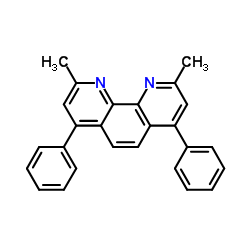Bathocuproine

Bathocuproine structure
|
Common Name | Bathocuproine | ||
|---|---|---|---|---|
| CAS Number | 4733-39-5 | Molecular Weight | 360.450 | |
| Density | 1.2±0.1 g/cm3 | Boiling Point | 531.9±50.0 °C at 760 mmHg | |
| Molecular Formula | C26H20N2 | Melting Point | 279-283 °C(lit.) | |
| MSDS | Chinese USA | Flash Point | 231.0±21.4 °C | |
| Symbol |

GHS07 |
Signal Word | Warning | |
|
A highly efficient universal bipolar host for blue, green, and red phosphorescent OLEDs.
Adv. Mater. 22 , 2468 - 2471, (2010)
|
|
|
Metabolic Impacts of Using Nitrogen and Copper-Regulated Promoters to Regulate Gene Expression in Neurospora crassa.
G3 (Bethesda) 5 , 1899-908, (2015) The filamentous fungus Neurospora crassa is a long-studied eukaryotic microbial system amenable to heterologous expression of native and foreign proteins. However, relatively few highly tunable promoters have been developed for this species. In this study, we... |
|
|
Copper directs ATP7B to the apical domain of hepatic cells via basolateral endosomes.
Traffic 15(12) , 1344-65, (2014) Physiologic Cu levels regulate the intracellular location of the Cu ATPase ATP7B. Here, we determined the routes of Cu-directed trafficking of endogenous ATP7B in the polarized hepatic cell line WIF-B and in the liver in vivo. Copper (10 µm) caused ATP7B to e... |
|
|
Biotinylated probes of artemisinin with labeling affinity toward Trypanosoma brucei brucei target proteins.
Anal. Biochem. 482 , 25-31, (2015) We studied the target proteins of artemisinin in Trypanosoma brucei brucei using the affinity-labeling method. We designed and synthesized four biotinylated probes of artemisinin for use as molecular tools. Their in vitro trypanocidal activities (data not sho... |
|
|
Oxidative DNA damage induced by carcinogenic dinitropyrenes in the presence of P450 reductase.
Chem. Res. Toxicol. 17(12) , 1750-6, (2004) Nitropyrenes are widespread in the environment due to mainly diesel engine emissions. Dinitropyrenes (DNPs), especially 1,8-dinitropyrene (1,8-DNP) and 1,6-dinitropyrene (1,6-DNP), are much more potent mutagens than other nitropyrenes. The carcinogenicity of ... |
|
|
Copper signaling axis as a target for prostate cancer therapeutics.
Cancer Res. 74(20) , 5819-31, (2014) Previously published reports indicate that serum copper levels are elevated in patients with prostate cancer and that increased copper uptake can be used as a means to image prostate tumors. It is unclear, however, to what extent copper is required for prosta... |
|
|
Rad9 interacts with Aft1 to facilitate genome surveillance in fragile genomic sites under non-DNA damage-inducing conditions in S. cerevisiae.
Nucleic Acids Res. 42(20) , 12650-67, (2014) DNA damage response and repair proteins are centrally involved in genome maintenance pathways. Yet, little is known about their functional role under non-DNA damage-inducing conditions. Here we show that Rad9 checkpoint protein, known to mediate the damage si... |
|
|
Metal complexes with superoxide dismutase-like activity as candidates for anti-prion drug.
Bioorg. Med. Chem. Lett. 16 , 5982-7, (2006) Various compounds were evaluated for ability to inhibit the formation of the abnormal protease-resistant form of prion protein (PrP-res) in two cell lines infected with different prion strains. Examination of the structure-activity relationships indicated tha... |
|
|
Disulfiram (DSF) acts as a copper ionophore to induce copper-dependent oxidative stress and mediate anti-tumor efficacy in inflammatory breast cancer.
Mol. Oncol. , doi:10.1016/j.molonc.2015.02.007, (2015) Cancer cells often have increased levels of reactive oxygen species (ROS); however, acquisition of redox adaptive mechanisms allows for evasion of ROS-mediated death. Inflammatory breast cancer (IBC) is a distinct, advanced BC subtype characterized by high ra... |
|
|
The mechanisms of oxidative DNA damage and apoptosis induced by norsalsolinol, an endogenous tetrahydroisoquinoline derivative associated with Parkinson's disease.
J. Neurochem. 108(2) , 397-407, (2009) Tetrahydroisoquinoline (TIQ) derivatives are putative neurotoxins that may contribute to the degeneration of dopaminergic neurons in Parkinson's disease. One TIQ, norsalsolinol (NorSAL), is present in dopamine-rich areas of human brain, including the substant... |